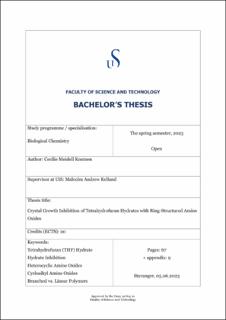| dc.description.abstract | Gas hydrates are clathrate crystalline solids created when water and small gas molecules are subjected to high pressures and low temperatures. Gas hydrate formation is a major problem in the oil and gas industry as it can plug subsea pipelines and stop production. Many methods are used to prevent gas hydrate formation, including chemical treatments. Thermodynamic hydrate inhibitors (THIs) and low-dosage hydrate inhibitors (LDHIs) are different chemical treatments used commercially today. LDHIs have two subclasses: kinetic hydrate inhibitors (KHIs) and anti-agglomerants (AAs).
This thesis's first project aimed to synthesize and test a series of amine oxides with ring structures, either cycloalkyl or heterocyclic groups, to see if they had the potential to be KHI synergists or AAs in the oil and gas industry. The test method used is called the THF-hydrate crystal growth test, where the crystal growth is measured in grams/ hour. The cycloalkyl amine oxides showed excellent inhibiting performance of THF hydrates. Especially the amine oxides with 6- and 7-membered cycloalkyl groups alkylated with butyl and pentyl. They inhibited THF hydrates at certain concentrations better than TBAB, TPAB, TBAO, and TPAO and should be further tested on gas hydrate mixtures as potential KHI synergists or AAs. Different placements and numbers of the cycloalkyl groups on amine oxides were carried out to find the best cycloalkyl amine oxide inhibitor. It was confirmed that one cycloalkyl group bonded to an amine oxide increased the inhibiting performance as an alkylamine was butylated to compare. The different heterocyclic amine oxides (4000 ppm) gave poor inhibiting performances of THF hydrate. One exception was Di-n-butyltetrahydrofurfurylamine oxide which gave a better inhibition performance than the commercially used TBAB.
The thesis's second project entailed comparing the inhibition of THF hydrates of the commercially used linear polymer Polyvinylcaprolactam (PVCap) with different branched polymers. This was evaluated by comparing the limiting concentration for zero growth (LCZG) on a THF rig. Unreliable results caused by the low water solubility of the branched polymers impacted the project´s success. Yet, the branched polymer trimethylolpropane triacrylate (60:1) with three branches showed a better LCZG (2100 ppm) than PVCap (3000 ppm). | |
